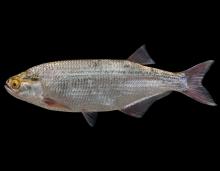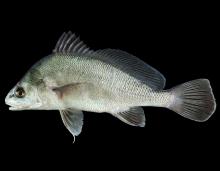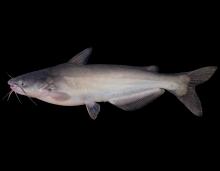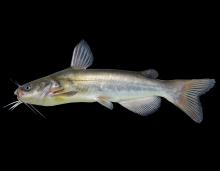Fishes
Media

Species Types
Scientific Name
Dorosoma petenense
Description
The threadfin shad occurs in the Mississippi River and its tributaries. It also occurs in mainstem reservoirs of the White River Basin and in Montrose Lake and the South Grand River in Henry County.
Media

Species Types
Scientific Name
Alosa chrysochloris
Description
The skipjack herring is an active fish, moving about continuously in large schools. It probably occurs at least occasionally in most of the large rivers of the state where its migrations are not blocked by dams.
Media

Species Types
Scientific Name
Alosa alabamae
Description
The Alabama shad is uncommon in Missouri. It spends most of its adult life in the sea and enters freshwater streams to spawn. Missouri may have the last spawning populations that occur in the Mississippi River system.
Media

Species Types
Scientific Name
Hiodon tergisus
Description
Mooneyes are silvery, flat-sided fishes with large eyes and prominent teeth on the jaws, roof of the mouth, and tongue. A fleshy keel runs along the midline of the belly. The eye is silvery and larger than the goldeye’s.
Media

Species Types
Scientific Name
Hiodon alosoides
Description
Goldeyes are silvery, flat-sided fishes with large eyes and prominent teeth on the jaws, roof of the mouth, and tongue. A fleshy keel runs along the midline of the belly. The iris of the goldeye is golden.
Media

Species Types
Scientific Name
Aplodinotus grunniens
Description
The freshwater drum is a silvery, deep-bodied fish with a distinct humpbacked appearance. It occurs in large rivers, lakes, and impoundments over most of Missouri.
Media

Species Types
Scientific Name
Percopsis omiscomaycus
Description
The trout-perch is the only Missouri fish with both an adipose fin and rough-edged scales. In Missouri, it occurs only in the Grand and Chariton River systems, but its range used to be much greater. It is on the verge of disappearing from our state.
Media

Species Types
Scientific Name
Ictalurus furcatus
Description
The blue catfish is a big-river fish, preferring swift chutes, pools with noticeable current, and silt-free substrates. In Missouri, it's most common in the Mississippi, Missouri, and Osage rivers.
Media

Species Types
Scientific Name
Ameiurus catus
Description
The white catfish is often stocked in fee-fishing lakes and other private waters. It sometimes escapes into natural stream systems. Unlike our other bullheads, it has a moderately (though not deeply) forked tail fin.
Media

Species Types
Scientific Name
Esox masquinongy
Description
The muskellunge is long and slender, with a mouth full of razor-sharp teeth. This big, nonnative pike is stocked in selected lakes in the Ozark region and near St. Louis.
See Also


Media

Species Types
Scientific Name
Amphiuma tridactylum
Description
The three-toed amphiuma is an eel-like, completely aquatic salamander. It has very small forelimbs and hind limbs, each with three tiny toes. In Missouri it’s found only in the Bootheel region.
Media

Species Types
Scientific Name
Siren intermedia nettingi
Description
The western lesser siren is an eel-like, aquatic salamander with external gills, small eyes, small forelimbs with four toes, and no hind limbs. In Missouri, it’s found mostly in the Bootheel and northward in counties near the Mississippi River.
About Fishes in Missouri
Missouri has more than 200 kinds of fish, more than are found in most neighboring states. Fishes live in water, breathe with gills, and have fins instead of legs. Most are covered with scales. Most fish in Missouri “look” like fish and could never be confused with anything else. True, lampreys and eels have snakelike bodies — but they also have fins and smooth, slimy skin, which snakes do not.





















